UTAH WOMEN’S HISTORY / Explore the History / Frequently Asked Questions
Frequently Asked Questions
What does “suffrage” mean? Does it have anything to do with suffering?
 Sure, suffrage may sound a bit like suffering, and some people even misspell and mispronounce it as “sufferage,” but suffrage has nothing to do with suffering. The word comes from the Latin suffragium, meaning “vote”, “political support”, and “the right to vote.” So women’s suffrage refers to women’s right to vote.
Sure, suffrage may sound a bit like suffering, and some people even misspell and mispronounce it as “sufferage,” but suffrage has nothing to do with suffering. The word comes from the Latin suffragium, meaning “vote”, “political support”, and “the right to vote.” So women’s suffrage refers to women’s right to vote.
Were the women who fought for suffrage "suffragists" or "suffragettes"? I’ve heard both terms used. Which one is best?
The term “suffragette” was first used in the Daily News, a London newspaper, in 1906 as a way to diminish and ridicule the work of British suffragists. The ending “ette” was used to depict these women as small imitations. Later, British suffragists who believed in more radical tactics (i.e. breaking windows, setting fires, etc.) adopted the label “suffragette” as a way to differentiate themselves from the more conservative suffragists who preferred traditional tactics of negotiation and lobbying. However, most American women, including Utah women, preferred the term “suffragist,” choosing not to identify with the insulting term. Find more info here.
What prompted the beginning of the women’s suffrage movement?

Elizabeth Cady Stanton
The Seneca Falls, New York Convention of July 19-20, 1848 is widely considered to be the start of the women’s suffrage movement. Elizabeth Cady Stanton and Lucretia Mott spearheaded the two-day conference “to discuss the social, civil, and religious condition and rights of woman.” Participants at the conferences signed a Declaration of Sentiments urging women to work for the right to vote, among many other reforms. Women’s rights advocates thought that gaining the vote would be a tool for them to remedy women’s legal, social, professional, and religious inequalities. Although women had called for voting rights in other circumstances before the Seneca Falls, suffrage organizations traced their beginnings back to this 1848 convention. The first national convention on women’s rights that included a discussion of the vote was held in Worcester, Massachusetts in 1850.
Wasn’t Wyoming the first territory or state to extend voting rights to women?
 Yes, Wyoming Territory was the first to pass a women’s suffrage law on December 10, 1869. Utah Territory was the second place to grant women’s voting rights, doing so just two months later on February 12, 1870. However, Utah held a municipal and a territorial election before Wyoming’s next election, so Utah women made history by casting their ballots first. The women who voted in Salt Lake City’s municipal election on February 14, 1870 were the first American women to cast ballots under a women’s suffrage law. A few thousand women later cast ballots in Utah’s territorial election on August 1, 1870. Women in Wyoming first voted on September 6, 1870. Learn more about the Wyoming history here.
Yes, Wyoming Territory was the first to pass a women’s suffrage law on December 10, 1869. Utah Territory was the second place to grant women’s voting rights, doing so just two months later on February 12, 1870. However, Utah held a municipal and a territorial election before Wyoming’s next election, so Utah women made history by casting their ballots first. The women who voted in Salt Lake City’s municipal election on February 14, 1870 were the first American women to cast ballots under a women’s suffrage law. A few thousand women later cast ballots in Utah’s territorial election on August 1, 1870. Women in Wyoming first voted on September 6, 1870. Learn more about the Wyoming history here.
When did Utah first allow women to vote?
The Utah Territorial Legislature first extended voting rights to women citizens on February 12, 1870. Seraph Young and about twenty-five other women voted in a Salt Lake City municipal election two days later, on February 14, 1870. This election was the first in the United States in which women cast ballots under a women’s suffrage law. Women citizens voted in Utah until 1887, when Congress revoked their voting rights. Utah’s state constitution restored women’s voting rights in 1896. The state constitution allowed women to hold public office for the first time.
Did this legislation grant voting rights to all women in Utah? Are there instances in Utah history when the voting rights of certain groups were limited or restricted?

U.S. President Calvin Coolidge with four Osage Indians after Coolidge signed the bill granting Indians full citizenship. Photo courtesy of Library of Congress
Congress did not grant U.S. citizenship to Native Americans until the passage of the Indian Citizenship Act in June 1924. Without citizenship, Native women could not vote. Even after the passage of this act, some Native Americans were still unable to vote. Since voting rights have traditionally been controlled by states, some states had laws specifically barring Native Americans, or those living on reservations, from voting.
As in other states, most Native Americans in Utah did not have voting rights until 1924 because they were not considered U.S. citizens. Previously, they had been designated only as citizens of their own nations, and thus ineligible to vote in U.S. elections. After 1924, many Native Americans living in Utah were not allowed to vote if they lived on a reservation. It wasn’t until 1957 that the Utah state legislature repealed the legislation that had prevented Native Americans living on reservations from voting.
Many immigrants from Asian countries were legally prohibited from becoming U.S. citizens (with voting rights) until Congress changed this by passing the McCarran–Walter Act of 1952. During World War II, tens of thousands of Japanese Americans were interned in camps under the guise of national security. While stripped of their rights, those who were U.S. citizens were still allowed to vote. For more information, read here.
Other women of color were not prohibited from voting by Utah or U.S. law, but that does not mean they did not face social and other difficulties in registering and voting. Click here for more information on Black women’s political participation in early Utah.
When and where did women in Utah first vote in an election?

Council Hall. Photo courtesy of Utah State Historical Society
Women in Salt Lake City voted in a municipal, or local, election on February 14, 1870, in Council Hall, two days after the territorial legislature passed a women’s suffrage law. Seraph Young was the first to cast her ballot, and about 25 other women voted as well. On August 1, 1870, a few thousand Utah women cast their ballots in Utah’s general election. Since Wyoming did not hold an election until September 6, 1870, women in Utah were the first to cast their ballots under an equal suffrage law.
The February 1870 election was also the first in Utah Territory that included opposing political parties, with the formation of the Liberal Party and the People’s Party just days before the election. This made Utah women’s political participation all the more significant.
Council Hall used to stand on the southeast corner of State Street and 100 South (where the Wallace F. Bennett Federal Building now stands), but the building was moved to its current location just south of the Utah Capitol Building in 1961. It now houses the Utah Office of Tourism. A women’s history monument will be installed in August 2020 to commemorate this historic first vote and subsequent legislation that gave more American women access to the ballot box.
Who was the first woman in Utah to vote?

The mural by David Koch of Seraph Young and others voting hangs in the Utah State Capitol.
Seraph Young, a schoolteacher, voted on her way to work on February 14, 1870. A mural depicting Seraph and other women first voting in Utah, by painter David Koch, hangs in the House of Representatives chamber in the Utah Capitol Building.
Why did many Western states grant women’s suffrage before most Eastern states?
 The first states (as opposed to territories) to grant women’s suffrage were in the West: Wyoming (1890), Colorado (1893), Utah and Idaho (1896), Washington (1910), California (1911), and Oregon, Kansas, and Arizona (1912). Though reasons for each state’s granting of women’s suffrage are as diverse as the states themselves, one factor is common among many of them. As Susan B. Anthony explained, it was much easier for (Western) territories to secure equal suffrage in their proposed constitutions as they applied for statehood, than it was for Easterners to make amendments to their already existing constitutions (which had long precluded women from voting). And many western states first had referenda on women’s suffrage when they were territories in the mid-1800s, long before suffragists finally won the vote through state referenda in the early 1900s.
The first states (as opposed to territories) to grant women’s suffrage were in the West: Wyoming (1890), Colorado (1893), Utah and Idaho (1896), Washington (1910), California (1911), and Oregon, Kansas, and Arizona (1912). Though reasons for each state’s granting of women’s suffrage are as diverse as the states themselves, one factor is common among many of them. As Susan B. Anthony explained, it was much easier for (Western) territories to secure equal suffrage in their proposed constitutions as they applied for statehood, than it was for Easterners to make amendments to their already existing constitutions (which had long precluded women from voting). And many western states first had referenda on women’s suffrage when they were territories in the mid-1800s, long before suffragists finally won the vote through state referenda in the early 1900s.
Why was Utah at the forefront of the women’s suffrage movement?
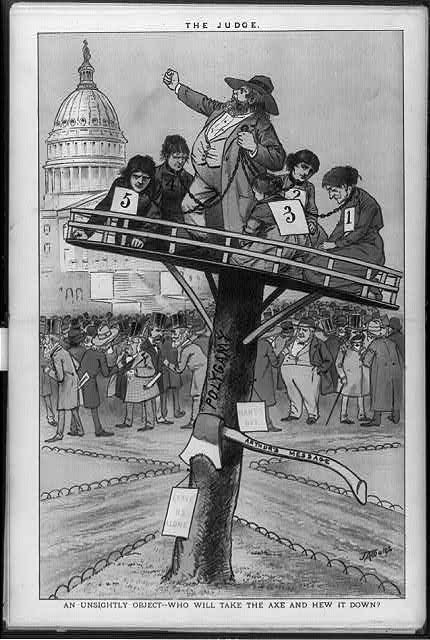 Historians point to various factors that led to women in Utah obtaining voting rights with little effort and decades before other states and territories. Read on for some factors, or read more here.
Historians point to various factors that led to women in Utah obtaining voting rights with little effort and decades before other states and territories. Read on for some factors, or read more here.
The Republican Party was formed in 1856 on the platform of ridding the nation of the “twins relics of barbarism”–slavery and polygamy. After slavery was abolished and black men received voting rights through the 15th Amendment to the Constitution, many American reformers turned their attention from ending slavery to ending polygamy. They considered polygamy morally wrong and oppressive to women.
In the 1800s, many leaders and members of the Utah-based Church of Jesus Christ of Latter-day Saints practiced polygamy. Some anti-polygamists believed giving Utah women voting rights would empower them to end polygamy. Latter-day Saints believed that Mormon women in Utah would use their vote to show their support for their religious practice of polygamy. They also thought that giving Utah women the vote would be a way to change negative views and perceptions about the LDS Church and the way women were treated in Utah. They wanted to show that Mormon women were not oppressed, helpless, and enslaved as many anti-polygamists believed.
In addition, Congress introduced the anti-polygamy Collum Bill in 1869-70. By granting Utah women a voice in political affairs, they too could help fend off anti-polygamy measures. And by granting women the vote, Utah also garnered the political support of a number of powerful national suffragists, like Susan B. Anthony.
Another likely contributing factor was the completion of the transcontinental railroad in 1869, which brought an influx of non-Mormon settlers to Utah Territory and an increase in a “cultural war” between the Mormons who had settled the territory and the newcomers. The election of February 14, 1870, was also the first in Utah Territory that included opposing political parties, with non-Mormon settlers establishing the Liberal Party and the Latter-day Saints creating the People’s Party. Extending the vote to female citizens, most of whom were Mormon, greatly increased the political power of the People’s Party.
Did the LDS Church support women’s suffrage?
While the LDS Church did not take an official stand on the issue, many church leaders publicly expressed their support for Utah women’s suffrage. Most church members were also very supportive of women’s voting rights, from the time that the Utah Territorial Legislature passed a women’s suffrage law in 1870 onward.
What role did the LDS Relief Society play in Utah’s suffrage movement?
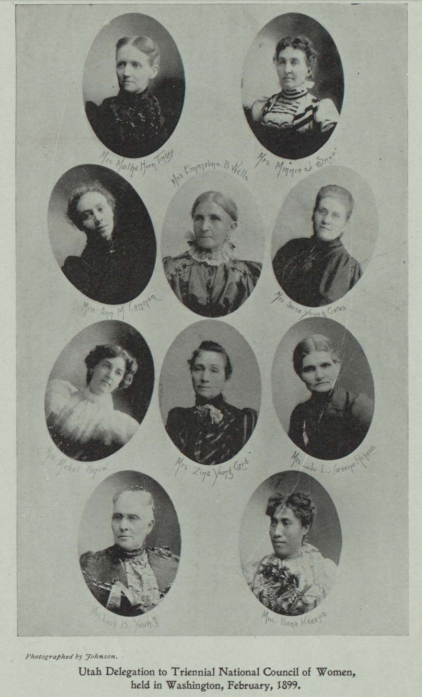
Utah delegation to the Triennial National Council of Women, held in Washington, D.C., February 1899. Top row: (L to R) Martha Horne Tingey, Minnie. J. Snow. Second row: Ann M. Cannon, Emmeline B. Wells, Susa Young Gates. Third row: Mabel Lyon, Zina Young Card, Lula L. Greene Richards. Bottom row: Lucy B. Young, Hana Kaaepa. Young Woman’s Journal 10 (May 1899): 194.
Utah’s Relief Society leaders–women like Sarah M. Kimball, Zina D.H. Young, and Emmeline B. Wells–were also leaders in Utah’s suffrage movement. They organized local suffrage meetings and also participated in national and international suffrage conventions, working with national suffragists. Emily S. Richards organized the Utah Woman Suffrage Association (UWSA), an affiliate of Susan B. Anthony’s National Woman Suffrage Association (NWSA), in 1888. Richards then organized local suffrage associations in conjunction with local Relief Societies throughout Utah and the intermountain West. By 1891, Utah women were welcomed into membership in the International and National Councils of Women.
What role did non-Mormon suffragists play in Utah’s suffrage movement?
Non-Mormon women played an interesting and often conflicted role in Utah’s suffrage movement. As anti-polygamy forces strengthened in the 1880s, non-Mormon suffragists became increasingly divided over the issue of Utah women’s suffrage. Many supported the principle of universal suffrage but held that granting the vote to Utah women only strengthened the political power of the LDS Church and perpetuated the practice of polygamy.

Cornelia Paddock
In 1884, Cornelia Paddock–who had served on the executive committee of the National Woman Suffrage Association (NWSA) at the same time that polygamous suffragist Emmeline B. Wells served as the NWSA vice-president representing Utah–joined other anti-polygamy Utah women in petitioning Congress to abolish the women’s vote in Utah. Others, such as Jennie Froiseth, the editor of Utah’s Anti-Polygamy Standard, did not support the removal of Utah women’s suffrage but joined other anti-polygamy women in lobbying to exclude Mormon women from national suffrage organizations.
After the 1887 Edmunds-Tucker Act disfranchised all Utah women, non-Mormon suffragist Isabel Cameron Brown was appointed delegate for Utah to the NWSA convention in Washington D.C. Brown, along with delegate Emily S. Richards (a monogamous Mormon), secured authorization to organize a territorial chapter of the NWSA. The 1889 formation of the Utah Woman Suffrage Association (UWSA) included a few non-Mormon women, although Froiseth and many other non-Mormon Utah suffragists actively opposed the formation of the organization and refused to join.
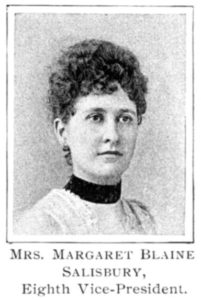 Tensions between Mormon and non-Mormon suffragists finally eased after the LDS Church officially disavowed polygamy in 1890, allowing for more cooperation leading to statehood and suffrage. Margaret Blaine Salisbury served with her Mormon friends on the Utah Board of Lady Managers, which was responsible for representing Utah at the 1893 Chicago World’s Fair, where hundreds of women of various faiths worked side by side to represent Utah’s progressive stance on women. Women of all faiths and both political parties joined the Utah Council of Women (now the Utah League of Women Voters), formed in 1896 by national suffrage leader Carrie Chapman Catt.
Tensions between Mormon and non-Mormon suffragists finally eased after the LDS Church officially disavowed polygamy in 1890, allowing for more cooperation leading to statehood and suffrage. Margaret Blaine Salisbury served with her Mormon friends on the Utah Board of Lady Managers, which was responsible for representing Utah at the 1893 Chicago World’s Fair, where hundreds of women of various faiths worked side by side to represent Utah’s progressive stance on women. Women of all faiths and both political parties joined the Utah Council of Women (now the Utah League of Women Voters), formed in 1896 by national suffrage leader Carrie Chapman Catt.
Congress took away Utah women’s voting rights in 1887, seventeen years after Utah women began exercising their voting rights. Why?
After receiving the vote, women throughout Utah became very involved in political life. However, most Utah women did not vote for candidates opposed to polygamy like anti-polygamists had hoped. The practice of polygamy continued.
Since giving Utah women the vote did not end polygamy, anti-polygamists worked through Congress to pressure the LDS Church to disavow polygamy through anti-polygamy laws. They also argued that Utah women’s votes were upholding the current political system and religious practices in Utah, so they should not be allowed to vote anymore.
In 1882, Congress passed the anti-polygamy Edmunds Act that took voting rights away from both female and male polygamists. In 1887, Congress passed further legislation, the Edmunds-Tucker Act, in another effort to end polygamy. Part of this legislation took away the voting rights of polygamous men and all Utah women, whether they were Mormon or non-Mormon, polygamous or monogamous, married or single.
How did women in Utah regain their voting rights?

Utah Woman Suffrage Association banner, 1893. Photo courtesy of International Society Daughters of Utah Pioneers
Many Utah women were angry that their voting rights were taken away, and they worked hard to win them back. In 1889, they created the Utah Woman Suffrage Association, an affiliate of Susan B. Anthony’s National Woman Suffrage Association, and organized local chapters throughout Utah.
In 1890, LDS Church president Wilford Woodruff officially announced the end of the contracting of new plural marriages in Utah. With this official change in policy, Congress passed the Enabling Act of 1894, which allowed Utah to apply for statehood. During Utah’s 1895 Constitutional Convention, delegates debated whether to include women’s suffrage and their right to hold public office in the state constitution that Utah would propose to Congress.
In contrast to other areas of the nation, most Utahns supported a woman’s right to vote and hold public office. Both political parties in Utah supported these rights in their party platforms, and women’s suffrage organizations throughout the territory lobbied delegates to include these rights in Utah’s constitution. The new constitution was overwhelmingly approved by Utah’s voters (still all male), was ratified by Congress, and signed by President Grover Cleveland on January 4, 1896, making Utah a state.
Who were the key players involved in Utah’s suffrage movement?
See our growing collection of short biographies.
Which national organizations promoted women's suffrage?
In 1869, the women’s suffrage movement split into the National Woman Suffrage Association (NWSA), headed by Elizabeth Cady Stanton and Susan B. Anthony, and the American Woman Suffrage Association (AWSA), headed by Julia Ward Howe, Lucy Stone, and abolitionist men. The NWSA disagreed with abolitionists’ and Republican supporters seeking black men’s civil rights at the expense of women’s rights. The NWSA sought national women’s suffrage through an amendment to the U.S. Constitution, while the AWSA sought to secure women’s suffrage state by state. Read more here about Utahns’ affiliations with both organizations.
These organizations merged in 1890 to form the National American Woman Suffrage Association (NAWSA), which in some ways continued both strategies. By the mid 1910s, however, NAWSA was focused on the passage of the 19th Amendment as the most likely way to enfranchise American women. Read more here about Utahns’ involvement with NAWSA.
The National Woman’s Party (NWP) broke away from NAWSA in the 1910s to pursue the vote through more direct action—parades, picketing the White House, campaigning against anti-suffrage legislators, etc. Utahns worked with the NWP as well as NAWSA to push for the 19th Amendment.
I've seen photos of purple, white, and gold suffrage banners and sashes. Why were those colors used?
The first major campaign for women’s suffrage in the U.S. was an 1867 referendum in Kansas. During that campaign, suffragists like Susan B. used the sunflower (the state flower) as a symbol of their cause. Yellow flowers and yellow ribbons became emblematic of the women’s rights movement and agitation for the vote; Utah suffragists often wore yellow flowers or ribbons at their rallies in the 1890s and decorated with yellow for suffrage events.
When the National Woman’s Party was formed in 1916, leader Alice Paul borrowed the color scheme used by British suffragettes. While the British movement used green, white, and violet (for give women the vote), Paul substituted gold for green to continue the American suffrage tradition.
Read more here about the meaning of the suffrage colors.
What ties did national suffrage leaders have with Utah suffragists?

Utah and other western suffragists with Susan B. Anthony (center) in 1895 at the Rocky Mountain Suffrage Association held in Salt Lake City
Even though National Woman Suffrage Association (NWSA) leaders were opposed to polygamy, they were still willing to work with polygamous suffragists and allow them to participate in their organization. The American Woman Suffrage Association (AWSA) would not align with those who supported polygamy. After the NWSA and AWSA merged to form the National American Woman Suffrage Association (NAWSA) in 1890 and the LDS Church officially ended the practice of polygamy in Utah that same year, NAWSA leaders become more supportive of Utah women’s voting rights.
National suffrage leaders often traveled to Utah to support and celebrate Utah women’s fight for suffrage. And Utah suffrage leaders frequently traveled east to attend and speak at national suffrage meetings and conferences. They also traveled abroad to the United Kingdom to attend international suffrage conferences, coordinating with British suffragists. Utah was held up to show that extending voting rights to women was beneficial and necessary
Read here to learn more about Susan B. Anthony’s ties to Utah.
What was the Woman’s Exponent? How was it important to the Utah suffrage movement?

The first issue of the Woman’s Exponent, June 1, 1872
The Woman’s Exponent, a newspaper published from 1872 to 1914 in Salt Lake City, sought to strengthen LDS women and to educate non-Mormons about Mormon women, though it was not officially affiliated with the LDS Church. Its content simultaneously supported women’s suffrage and advancement and polygamy. Reports about local and national suffrage meetings and conferences and editorials about women’s rights were frequently published. Louise Lula Greene was the newspaper’s first editor. Emmeline B. Wells served as associate editor starting with the Exponent’s first edition, then took over full editorial duties with Green’s departure in July 1877. Annie Wells Cannon, Emmeline’s daughter, assisted with editorial duties starting in 1905. Emmeline was forced to end publication of the Woman’s Exponent in 1914 due to a lack of financial resources and support. All forty-two years of the entire run of the Woman’s Exponent are housed at Brigham Young University’s Special Collections and can be accessed online.
When were Utah women’s voting rights returned? When did Utah women win the right to hold public office?
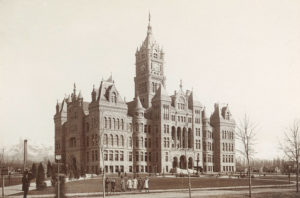
City and County Building, circa 1894. Photo courtesy of Utah State Historical Society
Debates about whether to include women’s suffrage in the state constitution took place over two weeks at Utah’s 1895 Constitutional Convention, held in Salt Lake City’s newly completed City and County Building. Franklin S. Richards and Orson F. Whitney were delegates who spoke strongly in favor of including women’s suffrage in the constitution. Despite minor opposition, with B. H. Roberts as the most vocal opponent, the delegates voted to include a clause in the Utah Constitution that guaranteed suffrage and right to hold office to Utah citizens regardless of their gender. Read more here about Utah suffragists’ efforts to include women’s voting rights in the state constitution.
Utah voters, all of them male, then voted overwhelmingly to approve the proposed Constitution. Utah women regained the vote in 1896, after Congress accepted Utah’s constitution and President Grover Cleveland officially made Utah a state on January 4, 1896.
Who were the first women elected in Utah?

Dr. Martha Hughes Cannon. Photo courtesy of LDS Church History Library.
Three women were elected to state legislative positions in 1896: Dr. Martha “Mattie” Hughes Cannon, a Democrat, became the first female state senator in the United States. Two more women, also Democrats, were elected to the state House of Representatives, Sarah E. Anderson of Ogden and Eurithe K. LaBarthe of Salt Lake City. At the county level, Margaret A. Caine was elected auditor of Salt Lake County, Ellen Jakeman was elected treasurer of Utah County, and eleven other women were elected as county recorders. To learn more about the women elected, read here.
After Utah women regained their voting rights, did they stay involved in the national suffrage movement?
After Utah women won their voting rights, some remained involved in winning those rights for other women throughout the nation. They continued to work with national suffrage organizations, helping to fund these organizations, serving as leaders in them, and attending national and international women’s rights conventions.
When was the 19th Amendment ratified?
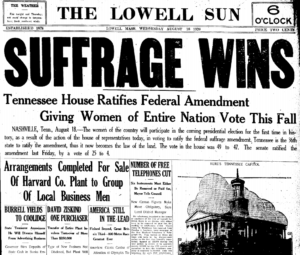
Front page of Lowell, Massachusetts newspaper, The Lowell Sun
Congress passed the 19th Amendment on June 4, 1919, but it was not ratified until August 18, 1920. Tennessee became the 36th state to ratify the amendment, giving it the two-thirds majority of state ratification necessary to make it law. The 19th Amendment took effect eight days later, on August 26, 1920. For more about this history, read here.
What rights did the 19th Amendment extend?
The 19th Amendment states: “The right of citizens of the United States to vote shall not be denied or abridged by the United States or by any state on account of sex.” Before the passage of this amendment, the Constitution only protected male citizens’ right to vote.
How many states and territories extended voting rights to women citizens prior to the passage of the 19th Amendment?
Nineteen:
- Wyoming (1869)
- Utah (1870)
- Colorado (1893)
- Idaho (1896)
- Washington (1910)
- California (1911)
- Oregon (1912)
- Arizona (1912)
- Kansas (1912)
- Alaska (1913)
- Illinois (1913)
- North Dakota (1917)
- Indiana (1919)
- Nebraska (1917)
- Michigan (1918)
- Arkansas (1917)
- New York (1917)
- South Dakota (1918)
- Oklahoma (1918)
What is the Voting Rights Act of 1965? Why was it necessary?

President Lyndon B. Johnson signs the Voting Rights Act of 1965 with Civil Rights leaders, including Martin Luther King, in attendance. Photo courtesy of Library of Congress
The Voting Rights Act of 1965 was signed into law by President Lyndon B. Johnson on August 6, 1965. Many states had restrictive legislation making it difficult, and in some instances, impossible for African Americans to vote. This legislation sought to put an end to these restrictive practices at state and local levels.
In June 2013, the U.S. Supreme Court ruled in the Shelby County vs. Holder case that two provisions of the Voting Rights Act of 1965 were unconstitutional. This provision specified that jurisdictions with a history of discrimination and voter suppression (mostly in the South) needed to receive prior federal approval from either the Department of Justice or a federal court regarding any changes made to election laws and procedures. Since this ruling, many states have changed their voting policies, including implementation of voter ID laws. For more information about this court case and its effects, read here.
What are current voting requirements in Utah?
To vote in Utah, one must be at least 18 years old, a citizen of the United States and a resident of Utah for at least 30 days prior to the election. You also need a state-issued, valid ID, a requirement not enforced by all states.
To learn about voter identification laws by state, read here.
How can I register to vote in Utah?
Visit the Utah Voter Registration Website for more information.
I’m a woman in Utah who is interested in running for public office. How can I find information and support for this endeavor?
Real Women Run is a collaborative, nonpartisan initiative to empower women to participate fully in public life and civic leadership through elected political office at all levels, appointments to boards and commissions, participation in campaigns, and engagement in the political system.
What is the current status of women in elected office in Utah and nationally?
To learn more about the current status of women in elected office in Utah and nationally, read The Status of Utah Women in Politics: A 2017 Update prepared by the Utah Women and Leadership Project (UWLP), and additional research briefs compiled by the UWLP about the status of women in Utah.
What is Better Days 2020?
For more information, visit www.betterdays2020.com

